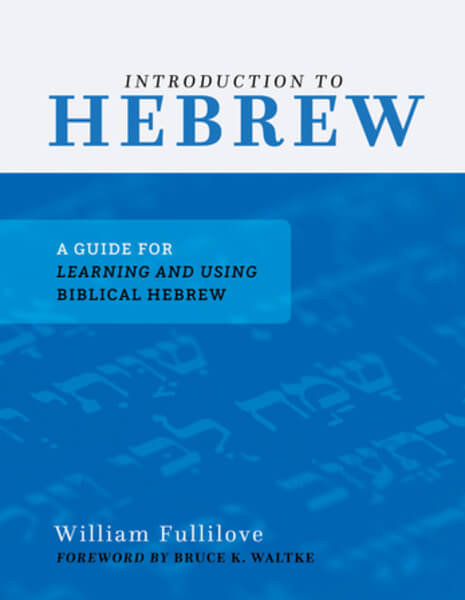Here is a textbook of Hebrew grammar you’ll wish your professor could have used—for reasons Bruce Waltke explains here (from his Foreword):
This book is the best introductory option for teaching Hebrew in a seminary, college, or university setting because it combines an expert understanding of the language with clear explanations that a beginning student can easily grasp. Dr. Fullilove’s teaching grammar combines several admirable features that make it so pedagogically successful:
- All its examples are from the biblical text, thereby keeping students constantly aware of their progress in reading and their growing capability.
- It quickly introduces the basic forms of the verb (Qal perfect and imperfect) in chapters 3 and 5, thereby introducing the linguistic center of the sentence as early as possible and maximizing students’ practice in parsing and translating verbs.
- The full paradigm of the strong verb is taught first, enabling students to gain a basic conception of the Hebrew verbal system before being weighed down by the myriad complexities of parsing forms built from weak verbal roots.
- Weak roots are held until the second half of the grammar and then introduced by type, enabling the student to see how the phonological impact of a weak consonant carries through the verbal system in a relatively regular way. Instead of overwhelming the viii student who has just been introduced to the Qal perfect, this method vastly simplifies teaching weak roots.
- Skills such as the proper use of a lexicon, the basics of word studies, and the use of the apparatus—skills that professors must usually teach in a supplemental way—are instead integrated into the grammar.
- With all of this, the grammar is not overlong, and it can easily be completed in two semesters of introductory language study.
Beyond all these features, however, what really makes this grammar sparkle is the final section of each chapter. Based on years of classroom teaching, Dr. Fullilove has crafted each final section as a set of exegetical exercises that require students to immediately apply the skills learned in that chapter to better understanding the Hebrew text. Even in chapter 1, for example, having learned only the alphabet, students are introduced to the acrostic poem and are asked (and able!) to analyze an incomplete acrostic and consider how the text of the poem is to be understood.
No better grammar is currently available to teach the beginning Hebrew student, especially the one interested in using Hebrew for the sake of biblical exegesis. In an age of slipshod preparation for ministry and exegesis, we need better-trained students who will become superior exegetes, both in the academy and in the church. This grammar is a welcome contribution to exactly that endeavor and a superb choice for the classroom teaching of Hebrew.Bruce K. Waltke
And this from James N. Anderson
Bill Fullilove’s mission is to make learning Biblical Hebrew as painless, productive, and pastorally relevant as it can be. . . . An invaluable resource. I highly recommend it.
Over the years I’ve gone back and worked through a few Hebrew grammars, and I’ve already begun the same with this one. If you need a refresher course in beginning Hebrew, here it is.
Fred Zaspel
